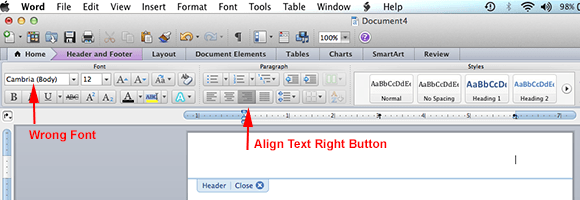- Free Microsoft Word Header Designs
- Microsoft Word Headers Templates
- How To Change Headers In Microsoft Word
- Insert Header Microsoft Word For Mac 2011 Help
You can make a new table from scratch in several different ways in Office 2011 for Mac. Even by using the Ribbon, making tables is a bit different depending upon the Office 2011 application you’re using.
Making a table using the Ribbon in Word and PowerPoint 2011
The steps to make a brand-new table in Word and PowerPoint are the same:
Position your cursor in your Word document or PowerPoint slide at the position where you want the upper-left corner of the table to be.
In Word, you can’t make tables in Notebook Layout view using the Ribbon. You can still use the Table menu, though.
On the Ribbon, click the Tables tab. In the Table Options group, click the New button.
When you click the New button, the pop-up menu appears.
Drag over the grid for the number of rows and columns to make.
Don’t worry about getting this just right. It’s easy to add and remove rows and columns after you make your table.
When you’re finished dragging, click over the grid to insert your table.
The table appears in your document or presentation.
May 14, 2018 How to Add a Header in Microsoft Word. This wikiHow teaches you how to add a repeating line of text to the top of each page of a Microsoft Word document. Open Microsoft Word. It's a blue app with a white 'W' on it.
Free Microsoft Word Header Designs
Making a table using the Ribbon in Excel 2011
Microsoft Word Headers Templates

Making a table in Excel is almost the same as in Word and PowerPoint, but not quite. Here’s what to do:
How To Change Headers In Microsoft Word
Select a range of cells to turn into a table.
The cells can be empty or already filled in.
On the Ribbon, click the Tables tab, find the Table Options group, and click the small triangle to the right of the New button.
A pop-up menu appears. Choose from these two options:
Insert Table with Headers:Tells Excel to use the top row of the selected cell range as headers.
Insert Table without Headers: Tells Excel there is no header row.
The cells become a table object within the worksheet. Notice that when making a table without headers, Excel puts a generic set of column headers above the table by default.
Customize the document headers and footers in Word 2011 for Mac to show page numbers, dates, and logos for formal stationery. You can work with headers and footers in several of Word 2011’s views. The quick way to work with headers and footers is by way of the Header and Footer group on the Office 2011 Ribbon’s Document Elements tab.
Clicking either the Header or Footer button displays a gallery from which you can choose a style for your header or footer. The basic layout of three positions (left, center, and right) is the first style on the palette. Notice that some styles affect only odd-numbered or even-numbered pages. Some of the styles apply tables to the header or footer, so if you click into one of these styles, the Format Tables tab on the Ribbon will activate.
When you choose a header or footer style, Word changes the interface so that you can type in your header or footer. You can display this view by choosing View→Header and Footerwithout having to choose a style from the Ribbon. To work with the interface, simply click into it and type. Click the Page # button on the Ribbon to display the Page Numbers dialog, which you can use to choose alignment and formatting options for your page numbers.
To exit Header and Footer view, choose a view from the views listed in the topmost group of the View menu, or double-click the document body. You can also click the small Close button below the Header or above the Footer area.

Insert Header Microsoft Word For Mac 2011 Help
You may want to format your Header or Footer to display Page # of #. To make this custom format starting without a Header or Footer style, do the following:
Choose View→Header and Footer from the menu bar.
Click within either the Header or Footer area.
Your cursor will be at the left. Press Tab once or twice to move to the center or right, if desired.
Type the word “Page,” followed by a space.
Choose Insert→Field from the menu bar.
Make sure that Categories is set to (All). Under Field names, choose Page and then click OK.
Add a space and then type of followed by another space.
Choose Insert→Field from the menu bar.
Under Field Names, choose NumPages and then click OK.